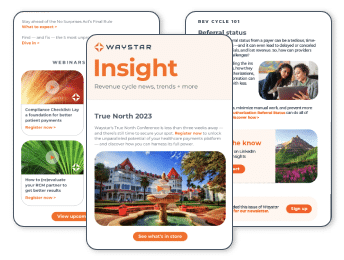Financially clearing patients is one of the most critical components of the revenue cycle, and money can often be lost before care is even delivered. With numerous patients experiencing annual changes in coverage, eligibility is no longer just a ‘yes or no’ question — you need to take benefit eligibility to the next level.
Comprehensive Eligibility Checks
Comprehensive eligibility checks are a lynchpin of every revenue cycle. If not verified correctly, there’s no ignoring the ripple effects. Some studies have demonstrated registration and benefit eligibility errors account for nearly a quarter of all denials. So it’s critical to proactively run eligibility checks across the lifecycle of a claim, from pre-service to pre-claim submission and even during pre-collections. After all, it could mean the difference between being in the red vs. in the black.
Running Eligibility Prior to Claim Submission
In fact, running eligibility prior to claim submission (especially with Medicaid plans or when care overlaps across months) is just as important as financially clearing a patient at the point of service. By taking advantage of smart RCM tools and setting up thoughtful checks along the way, however, eligibility-related denials can be mitigated.
Automating Your Process
It should come as no surprise that many providers still struggle with eligibility verification because many still handle the process manually. A 2020 report from CAQH revealed eligibility and benefit verification accounted for 47% of total medical spending. Meanwhile, the use of automation has allowed the healthcare industry to avoid spending an estimated $85.6B it otherwise would’ve cost to manually run eligibility and benefit checks. It’s clear the manual approach to eligibility eats up valuable staff hours with time-consuming tasks like calling the payer or logging onto their website, directly affecting productivity, customer service, and employee morale.
A comprehensive, accurate, and automated eligibility solution
Eligibility verification not only has a tremendous impact on an organization’s bottom line, but it also influences patient collection and satisfaction. A comprehensive, accurate, and automated eligibility solution provides patients much needed transparency when understanding their benefits and out-of-pocket responsibility while reducing the burden on staff to interpret and verify eligibility. Moreover, an effective solution will re-verify coverage at appropriate points throughout the claim lifecycle to ensure claims go out correctly the first time.
The Bottom Line
A rigorous clearance process starts with collecting the correct insurance details at scheduling, verifying coverage three to seven days prior to service, and ideally again during registration — particularly with Medicaid and Managed Medicaid plans or high-cost services. Eligibility should also be checked in certain post-service situations (particularly when eligibility cannot be verified upfront, the patient is pending coverage such as Medicaid or COBRA, discovering coverage for self-pay accounts, etc.).
An automated and accurate eligibility verification software simplifies such processes and flags potential registration errors, like managed care plans, to help prevent denials and ensure accurate recording of patient data.
The wrap-up
With the eligibility challenges growing ever more complex, a simple ‘yes or no’ check is no longer reliable. As so many Americans have lost or changed coverage due to the pandemic, it’s imperative to accurately verify eligibility and ensure your organization has access to the richest eligibility data available. It is called the revenue cycle after all, and the beginning of that cycle starts with correctly verifying eligibility to ensure providers get paid for the services rendered to their patients.
Learn more about Waystar’s Eligibility Verification.


